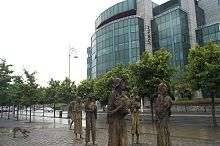International Financial Services Centre

The International Financial Services Centre (IFSC) is a major European Financial Centre located in North Wall, Dublin, Ireland. As of 2014 the centre ostensibly employs 35,500 people in over 500 companies and generating some 2.1 billion euro.[1] It was the brainchild of financier Dermot Desmond,[2] whose NCB financed a study by Price Waterhouse on the feasibilities of an 'IFSC'.[3] Desmond then approached Fianna Fáil leader Charles Haughey, then in opposition, who made it the centrepiece of his economic manifesto when he came back into power. The Finance Act, 1987 (Section 30) allowed for the designation of an area exempt from normal taxation laws. There has also been criticism of the influence of corporations associated with the IFSC in Irish politics.[4]
The IFSC comprises the area between Memorial Road, Amiens Street, Lower Sheriff Street (including part of Crinan Strand), Guild Street, and the River Liffey along North Wall Quay and Custom House Quay. Adjacent districts include East Wall to the north and Spencer Dock to the east; the Custom House, Busáras and the city centre lie to the west along Store Street and Abbey Street.
Within the IFSC, the original development area lies west of Commons Street. East of Commons Street is the later IFSC II area, along North Wall Quay and Lower Mayor Street. It is an integrated development located in the centre of the city which incorporates office accommodation, educational institutions, housing, restaurants and shopping facilities. It has expanded beyond its original site.
The centre now houses financial institutions, or at least their nameplates,[5] together with the law firms and accountancy and taxation advisors who support them. While the IFSC was ostensibly intended for foreign financial institutions, the first bank to take up residence was Allied Irish Bank. The National College of Ireland is situated within the IFSC.
There are currently more than 500 financial operations allowed to trade within the IFSC. According to the official website it is home to more than half of the worlds top 50 financial institutions including Citibank, Commerzbank and Sumitomo, as well as major international trading companies such as SIG.[6]
The response of the regulator which followed the Irish financial crisis has led many financial institutions to move operations elsewhere[7] and caused Dublin's ranking as a financial services centre to plummet from 10th in 2009 to 70th in 2014.[8] IFSC institutions cited the timeliness of decisions by the Central Bank of Ireland as having a significant impact on their operations.[9] The current government says it has a strategy to try to make the IFSC the centre of FinTech, by being "faster and slicker" than the UK and Germany in regualtion, although in 2015 Central Bank regulations for the rapidly growing sector look to be years away.[10]
External links
References
- ↑ http://www.ifsc.ie/page.aspx?idpage=6
- ↑ "Dermot Desmond". ashokaglabalizer.org. 21 June 2010. Retrieved January 21, 2010.
- ↑ "The Sunday Business Post". businesspost.ie. 2012. Retrieved 7 August 2012.
- ↑ http://soundmigration.wordpress.com/2012/10/26/ifsc-clearing-house-what-the-irish-times-doesnt-say-and-why-it-matters/
- ↑ http://www.irishtimes.com/business/sectors/financial-services/no-desks-no-staff-no-tax-ireland-s-shadow-banks-1.1388923
- ↑ "I.F.S.C". I.F.S.C.ie. 21 June 2010. Retrieved June 11, 2012.
- ↑ http://www.irishtimes.com/news/heavy-regulation-affects-ifsc-1.1383149
- ↑ "Dublin's ranking as a financial centre continues to plummet". Irish Times. 22 September 2014.
- ↑ "Banking body argues for strong signal on corporation tax rate in IFSC strategy". Irish Times. 14 February 2015.
- ↑ "Regulation for peer-to-peer lenders looks years away". Irish Independent. 26 February 2015.
Coordinates: 53°20′58.28″N 6°14′49.97″W / 53.3495222°N 6.2472139°W